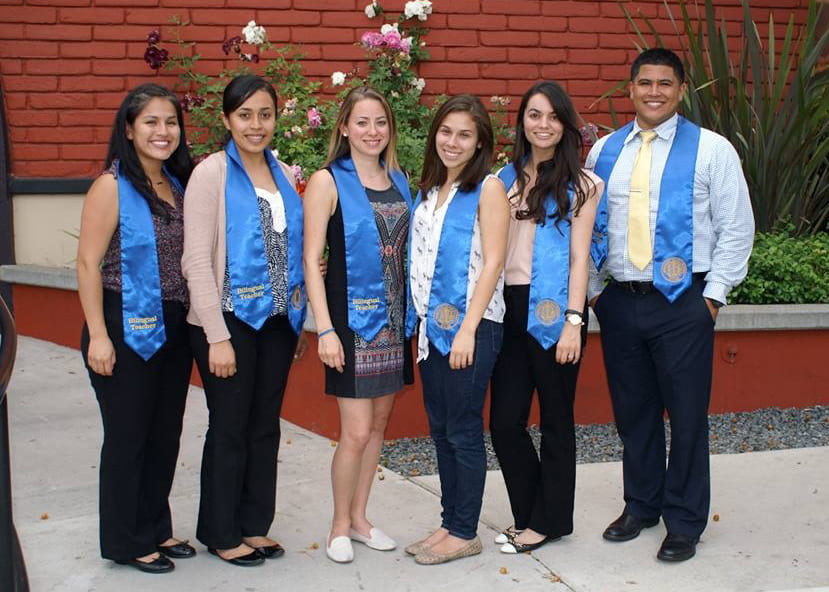Bilingual boom
UCI School of Education helps meet need for teachers in popular dual-language immersion classrooms

Parents who recognize the benefits of their children learning more than one language in school are supporting – even demanding – more highly qualified bilingual teachers. The School of Education at UC Irvine is helping fulfill that need.
“Locally, there has been tremendous growth in these dual-language immersion programs, with new ones opening every year,” says Susan Guilfoyle, an education lecturer at UCI and bilingual authorization coordinator. “It’s driven by a grass-roots movement of well-informed parents who value biliteracy for their children and know it’ll be an asset for their future. Dual immersion programs are very selective when hiring their bilingual teachers, and our candidates rank highly when interviewing for a position.”
There are currently about 105 dual-language immersion schools in Southern California, and the number is growing. Nationally, such programs have increased by 700 percent since 2002.
Dual-language immersion gives children from a variety of socioeconomic and cultural backgrounds the opportunity to achieve fluency in both English and a target language, such as Spanish or Mandarin.
Studies have shown that students who learn a foreign language early on demonstrate certain cognitive advantages over those who do not, including greater problem-solving and critical thinking skills and heightened creativity. There’s also a relationship between foreign language study and enhanced mathematical development.
As dual-language immersion has become more in demand, the need for highly qualified bilingual teachers has become more urgent. Students enrolled in the UCI School of Education’s Master of Arts in teaching and credential program can pursue (via examination) a bilingual authorization in Spanish or Mandarin that allows them to teach in dual-language immersion schools.
Those seeking a bilingual authorization along with a teaching credential receive student teaching assignments in schools where instruction is primarily in a language other than English or a percentage of the day is taught in a second language. UCI graduates eight to 11 such students each year, and many are employed at dual immersion sites in the area.
In 2014, 100 percent of the program’s bilingual credential graduates were hired by public grade schools, with the majority teaching in dual-language immersion programs throughout Orange and Los Angeles counties. Spanish, Mandarin and Korean are the most popular offerings in Southern California.
Among the local elementary schools snapping up these graduates are Ralph A. Gates, Las Palmas, Viejo, Marian Bergeson and Peter Marshall, as well as El Sol Science & Arts Academy – all of which are highly regarded by parents seeking to expose their children to dual-language learning.
Megan Gibbs, a 2014 graduate of UCI’s M.A. in teaching and credential program, teaches first grade in the Saddleback Valley Unified School District’s Ralph A. Gates Elementary School. She spends 90 percent of her day instructing in Spanish and 10 percent in English.
Gibbs first considered teaching high school Spanish but changed her mind when she discovered opportunities in dual-language immersion programs.
“I really didn’t know dual immersion existed until Susan [Guilfoyle] … told me that I would be a great candidate,” she says. Gibbs studied Spanish as an undergraduate at UC Santa Barbara and lived in Spain as a college student.
Fluency in “languages such as Spanish, Mandarin and German can be so lucrative and beneficial, depending on the industry you’re involved in,” she notes. “We have a waiting list at our school, and as soon as one student leaves, there’s another one immediately available to replace him.”
Sarah Shin, a 2012 graduate of the master’s program and bilingual authorization holder, teaches third-graders in a 50-50 English-Korean program at Monte Vista Elementary School in the Glendale Unified School District, which also offers dual immersion classes in Armenian, Spanish, Japanese, French, German and Italian.
“I like the challenge and the beauty of the dual-language programs in our district,” Shin says. “I have the opportunity to visit other dual-language teachers, and while we teach in different languages and have access to different resources, we all see the same excited reactions from students when they’re being challenged and pushed to learn in a second language.”
The interest in these programs reflects a significant cultural and demographic shift, says Kevin Reimer, director of undergraduate programs & student affairs in the UCI School of Education.
“The implications of multilingual education are profound,” he says. “There are potential economic benefits from students who have grown up with multilingual capability, as they will have a deeply established sense of cross-cultural fluidity and move back and forth more easily between cultures.”
Tanya Anaya is a native Spanish speaker who grew up in Southern California. She’ll complete her master’s degree at UCI this summer and is currently student teaching in a south Orange County dual-language elementary school.
“I love that I’m able to further extend my culture by teaching in Spanish to those who are native speakers and those who are not,” she says. “It’s really exciting to be able to instill this language in nonnative speakers.”
When Anaya was a child, her Santa Ana elementary school’s bilingual program was cut due to political pressure from English-only advocates. She’s pleased to see that parents and districts now are more receptive to dual-language learning.
“To be competitive in the workforce and in academics, you need a lot of different skills, and parents are thinking ahead,” Anaya says. “Being bilingual only makes you more marketable.”